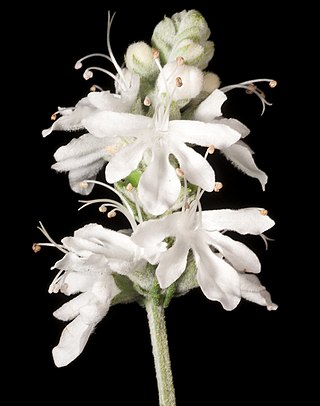
Conostylis is a genus of perennial herbs in the Haemodoraceae family, commonly known as cone flowers. All species are endemic to the south west of Western Australia.

Pomaderris oraria, commonly known as Bassian dogwood, is a species of flowering plant in the family Rhamnaceae and is endemic to south-eastern Australia. It is a compact shrub with hairy branchlets, hairy, elliptic leaves and panicles of hairy, greenish to cream-coloured or crimson-tinged flowers.

Conostylis aculeata, commonly known as prickly conostylis, is a flowering, tufted perennial plant in the family Haemodoraceae. It has flat leaves and yellow, hairy, tubular flowers. It is endemic to the south-west of Western Australia.

Conostylis albescens is a rhizomatous, tufted perennial plant species in the family Haemodoraceae, endemic to the south-west of Western Australia. Plants grow to between 12 and 17 cm high and produce yellow-cream-white flowers in August in the species' native range. The grey-green, hairy, leaves are 12–17 cm long and 0.8–1.5 mm wide.

Conostylis angustifolia is a rhizomatous, tufted perennial plant species in the family Haemodoraceae, endemic to the south-west of Western Australia. In September and October it produces yellow flowers in the species' native range.

Conostylis argentea is a rhizomatous, tufted perennial plant species in the family Haemodoraceae, endemic to the south-west of Western Australia. In July and August it produces white to cream flowers in the species' native range.

Teucrium eremaeum is a species of flowering plant in the family Lamiaceae and is endemic to the south-west of Western Australia. It is a perennial herb or shrub with small, linear to lance-shaped leaves and white or cream-coloured flowers.

Conostylis serrulata is a flowering plant in the family Haemodoraceae and is endemic to the south-west of Western Australia. It is a small perennial with yellow cream flowers and flat, green leaves.

Conostylis bealiana is a flowering plant in the family Haemodoraceae and is endemic to Western Australia. It has green flat leaves and tubular dark yellow to orange-red flowers.

Conostylis bracteata is a tufted perennial plant in the family Haemodoraceae and is endemic to the south-west of Western Australia. It is a rhizomatous, tufted, perennial, grass-like plant or herb with flat leaves and yellow, hairy, tubular flowers.

Conostylis breviscapa is a rhizomatous, tufted perennial, grass-like plant or herb in the family Haemodoraceae and is endemic to the south-west of Western Australia. It has flat leaves and yellow, hairy, tubular flowers.

Conostylis canteriata is a rhizomatous, tufted perennial, grass-like plant or herb in the family Haemodoraceae and is endemic to the south-west of Western Australia. It has stilted roots, flat leaves, and pale lemon-yellow tubular flowers.

Conostylis caricina is a flowering plant in the family Haemodoraceae and is endemic to the south-west of Western Australia. It is a rhizomatous, tufted perennial, grass-like plant or herb with flat leaves and heads of 6 to 8 creamy-yellow flowers.

Conostylis crassinerva is a rhizomatous, tufted perennial, grass-like plant or herb in the family Haemodoraceae and is endemic to the south-west of Western Australia. It has flat leaves and yellow tubular flowers that turn reddish as they age.

Conostylis deplexa is a rhizomatous, tufted or solitary perennial, grass-like plant or herb in the family Haemodoraceae and is endemic to the south-west of Western Australia. It has flat leaves and uniformly yellow, tubular flowers.

Conostylis dielsii is a tufted perennial, grass-like plant or herb in the family Haemodoraceae and is endemic to the south-west of Western Australia. It forms short rhizomes, and has cylindrical leaves and creamy-yellow flowers.

Conostylis drummondii is a rhizomatous, tufted perennial, grass-like plant or herb in the family Haemodoraceae and is endemic to the south-west of Western Australia. It has short stems, and has more or less cylindrical leaves and pale lemon-yellow flowers.

Conostylis festucacea is a rhizomatous, tufted or proliferous perennial, grass-like plant or herb in the family Haemodoraceae, and is endemic to the south-west of Western Australia. It has cylindrical or flat leaves and yellow flowers.

Conostylis juncea is a rhizomatous, tufted perennial, grass-like plant or herb in the family Haemodoraceae, and is endemic to the south-west of Western Australia. It has cylindrical or flat leaves and yellow flowers on a short flowering stem.
Conostylis latens is a rhizomatous, tufted perennial, grass-like plant or herb in the family Haemodoraceae and is endemic to the south-west of Western Australia. It has flat, green, usually hairy leaves, and greenish-yellow, tubular flowers.



















